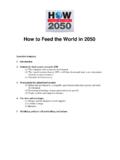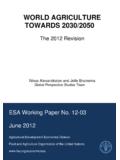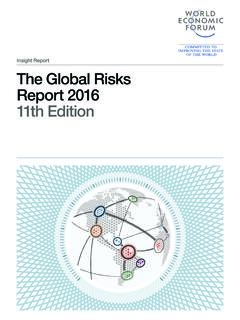Transcription of Estimating Demand for Agricultural Commodities …
1 Estimating Demand for Agricultural Commodities to 2050 By John Kruse Estimating Demand for Agricultural Commodities to 2050 By John Kruse Pre-publication draft, 3-16-10 | Page | 2 Estimating Demand for Agricultural Commodities to 2050 Background Over the next forty years, global population is expected to reach nine billion people. This increase, combined with expected economic growth, will cause an increase in nutritional Demand and inevitably strain the resources used for food production. In order to meet expected worldwide nutritional Demand while maintaining sustainable Agricultural practices, industries within the Agricultural supply chain seek foreknowledge of future nutritional demands.
2 Their goal is develop and deliver resources in such a way that global food needs are met efficiently and in sufficient quantity. Many previous studies have put together projections of global food Demand . These studies tend to make large commodity groupings such as cereals, oilseeds, meats, etc. and do not provide the granularity to specially identify the future Demand for a specific crop. In addition, important assumptions such as feed conversion, feed efficiency, technology, etc. are often not explicitly identified in the presentation of the results. These studies often do not explicitly discuss dietary change and income growth in the context of cultural and ethnic issues which shape this change.
3 The objective of this research was to develop a detailed forecast of global food Demand to 2050 with crop specific granularity and transparent assumptions regarding macroeconomics, technology, and policy. In developing this forecast, the cultural and ethnic issues specific to each country were carefully considered. A global forecast of food Demand through 2050 was developed by IHS Global Insight (IHS-GI) using their global Agricultural partial equilibrium modeling system. This modeling system includes not only food Demand for crop and livestock Commodities , but also feed, seed, and industrial Demand for crop Commodities .
4 More details on this model are included in the appendix. Projections are developed for each year from 2010 through 2050 based on IHS-GI macroeconomic projections for variables such as income growth, population growth, inflation, exchange rates and input costs. Other assumptions include Agricultural policies and technology. Constant policy assumptions are used through the forecast period. This includes meeting current ethanol and biodiesel mandates. EU biofuel targets are not reached despite the European Commissions insistence that penalties will be assessed on countries which do not reach the 10 percent target.
5 The experience of the EU biofuel industry, current subsidies, and barriers to higher biodiesel and ethanol blends make reaching the target extremely difficult even if generation 2 feedstock technologies were economical. Yield growth is based on linear trends estimated over the 1990 to 2008 period. In countries adopting new technologies that recently experience rapid yield growth, downward adjustments in yield trend estimates were made. The model recognizes saturation points in the Demand for various types of food products in developing countries based on the previous experience of developed countries with similar cultural or ethnic situations meat and food based on income.
6 The model also takes into consideration the decreasing sensitivity of food consumption Demand to income growth, as Estimating Demand for Agricultural Commodities to 2050 By John Kruse Pre-publication draft, 3-16-10 | Page | 3 income levels increase from below subsistent levels to those associated with the developed world. This study should be regarded as the first step in analyzing a very complex future and the results can be dramatically affected by the assumptions used in the analysis. The results reflect conservative assumptions grounded in the historical experience of dietary change.
7 Future analysis will consider alternative assumptions which could increase Agricultural commodity Demand above levels presented in this study. Critical Factors for the Analysis This study is primarily focused on projecting Demand for crop Commodities resulting from food Demand . The Demand for specific crop Commodities arising from food consumption includes not only direct human consumption of the crop, but also indirect consumption arising from the feed used to produce meat for human consumption. Other demands such as industrial and seed uses are included in the model.
8 Biofuels are included in industrial Demand . The policies which drove the rapid growth in corn and vegetable oil Demand for biofuel feedstocks mature by 2020 in the forecast with production of some biofuels falling short of current mandates and targets. The cellulosic targets will be especially difficult to reach without some advances in current technologies. European Union biofuel targets are also aggressive especially for biodiesel even considering biodiesel imports from Brazil, Argentina and the US. Food Demand Drivers Population Growth The rate of population growth is declining in all regions of the world.
9 Within the Commonwealth of Independent States, the population growth is actually negative. Historically, developed countries have lower population growth rates than developing countries. The developing regions of the world including the Middle East, Asia and Africa have historically had some of the fastest population growth rates but as we look forward from 2010, these rates are slowing. By 2050, Africa's population is still growing at over 1 percent per year compared with an average of percent for the world. This population growth rate limits their gains in per capita income growth.
10 By contrast, the population growth in the Asia/Oceania region falls from to allowing more significant gains in per capita income growth. Estimating Demand for Agricultural Commodities to 2050 By John Kruse Pre-publication draft, 3-16-10 | Page | 4 Population Growth Rate by Region Income Over the next 40 years an amazing transformation is projected to occur in today's developing countries driven by income growth. It is this income growth, particularly in developing countries, that enables populations to not only meet their daily calorie requirements, but also diversify their diet to include more proteins.






